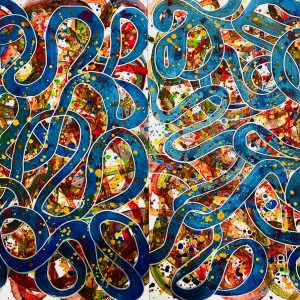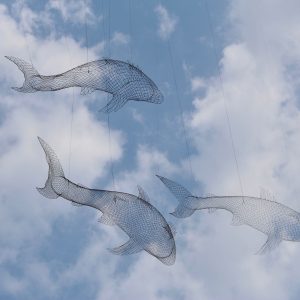Sometimes our creativity and productivity seem to flow, and other times we can’t think straight and produce mediocre work. Each of us has a preferred way of approaching and ordering daily activities and tasks, and if we plan according to our preferences – when and with whom we collaborate, create, solve problems, and make decisions – we naturally find our flow. In this article, InterGifted's founding director Jennifer Harvey Sallin helps us become aware of, and honor, our preferences.
by Jennifer Harvey Sallin | originally published on Rediscovering Yourself
LEARNING ABOUT OUR PREFERENCES
There are days when our creativity and productivity seem to unfold naturally and then there are days when everything feels stuck - our mind is overwhelmed or unclear, we procrastinate and do mediocre work at best. Have you ever contemplated what makes the difference? Each of us has a preferred way of approaching and ordering basic daily activities and tasks, but few of us are aware of our preferred "activities flow". So, many of us experience a sort of hit-or-miss phenomenon when it comes to experiencing productivity and pleasure on a consistent basis.
When we look closely at our daily activities and tasks, they can essentially be reduced to four main categories, which are like building blocks we use to create and co-create our experience of our selves and our life in any given moment. They are:
SENSING (DO)
Our most basic animal functions, including touch, taste, hearing, seeing, movement, and general sensational awareness; sensing forms the physiological basis of our emotions, and our senses are mostly experienced as being unlinked to or outside of time (“here and now”). This also translates into accomplishing – these are concrete tasks: doing things and getting things done. This is the least “mental” or "cognitive" of the four building blocks.
FEELING (PREFER)
Our subjective experience of our inner and outer senses and experiences. This is the "feeling” quality of existence, which we generally experience as being outside of time.
LOGIC (PLAN/DECIDE)
Our mental arrangements. We use our senses, feelings, and emotions to develop memory and thought. Thoughts are like little “experience packets” that we use to populate and organize our inner mind. Our thoughts arise from pattern recognition and statistical learning, and result in rule making, abstraction, and logical analysis. This requires a sense of past, present and future, and recycles our senses and feelings in order to create a sense of time and identity (see this article). In very practical terms, logic is what we use to make plans and decisions.
CREATIVITY (BRAINSTORM/IMAGINE)
Using our imagination to create new mental arrangements and to find creative solutions to problems. Using the “building blocks” of our sense and feelings experiences combined with our mental arrangements, we invent and innovate to construct new realities. Here we use time creatively to invent new ways of experiencing time. While creativity is not unique to humans, the level of complex creativity does seem to be unique to us.
Knowing and being aware of these preferences helps us plan appropriately for our life, career, daily functioning, self-care, and equally importantly, how and to whom we choose to communicate these plans and preferences. In essence, if we plan according to our preference, we will have productive and flowing days, and communication and collaboration will be a joy rather than a stress. If we try to work against our preferences, we face many more frustrating and unproductive days – and all the stress, problems and relational misunderstandings that come with them. So how can we learn about our preferences?
FEELINGS
Let's imagine a man named Joe who loves to discuss his and others' feelings, while his friend Sergio has a strong distaste for talking about feelings. It’s not necessarily that Joe is emotionally intelligent, and that Sergio is not. Rather, Joe may prefer “feeling” in an extroverted or collaborative way – sharing feelings with others, while Sergio may prefer to reflect on his feelings in a more introverted or introspective way. Where Joe wants others' input in the "feelings phase" of his daily flow, Sergio prefers to have access primarily to his own feelings, without input.
LOGIC
While Joe likes to discuss his and others’ feelings collaboratively, when it comes to making decisions, he prefers to reason through the logic of things in an introverted or introspective way. He prefers not to have logical input from others during this "logic phase" of his flow, deciding first within his own mind what is the right course of action, and only then sharing his decision. It’s not that Joe is insensitive to others’ needs, but rather, he must have access primarily to his own thoughts in order to make a conscious decision. In fact, when he is making decisions in his own mind, one of the logical building blocks he is using are the feelings he took in from others during his "feelings phase".
Let's compare that to Sergio's logic preferences: while he prefers not to discuss his and others' feelings, he needs input when it comes to logic processes and decision-making. He does best when he can discuss plans with others, receive input and feedback on logical considerations, and come to conclusions and decisions in a collaborative way. It’s not that he is “more collaborative” than Joe; he just prefers to collaborate with others in a logical way, rather than an emotional way. When Sergio makes logical decisions with others, one of the basic building blocks he will bring to the discussion are his feelings – the ones he felt privately during his introverted "feelings phase".
CREATING
When it comes to creating, Joe is less efficient and effective when he has others’ input. He is at his creative best when he is in his own mind considering options and possibilities, and feeling free to creatively vision as far and wide as he pleases without interruption. Sergio, on the other hand, loves to create collaboratively, in an extroverted way. Discussing ideas and possibilities with others helps him to generate more possibilities and gives him energy.
SENSING
Finally, Joe thrives on doing physical, practical, and other sensing activities with others. He feels good “sensing” the world with others, taking in the physical environment and accomplishing concrete tasks. He likes to make his ideas into a reality with others - on all levels, from the simplest (i.e. making dinner together or doing sport) to the more complex (i.e. creating a database for his research).
Sergio needs time alone during his "sensing phase". He needs to reorient himself toward his own body and senses, his own “here and now”, and the practical considerations of whatever he has been planning. He prefers to be on his own or in quiet company, doing the most practical things on all levels, from the simplest (i.e. cleaning the house) to the more complex (i.e. training for a marathon).
EXTROVERSION & INTROVERSION
Like Joe and Sergio, all of us have preferences for introversion during some daily activities and for extroversion during others. Contrary to what is commonly believed, none of us is completely introverted or extroverted, but rather we all experience alternating periods of introversion and extroversion throughout the day. All day, every day, for our entire lives, we oscillate between periods of needing to collaborate with others’ minds and periods of needing to have exclusive access to our own minds (between being “ourselves” and being “part of something bigger”, so to speak).
Introverts don’t like to do everything inside their own heads by default, nor do extroverts like input all the time and regarding every aspect of their lives. This is one reason why many people struggle to place themselves adequately on the scale of extroversion-introversion. The terms “introvert” and “extrovert” seem to imply only one mode of doing everything, but it’s more complex than that.
Usually, people who have a primarily introverted preference for relating to the world prefer non-collaborative activities as the first "building block" of their preferred flow. For example, I start my preferred flow in an introverted feelings way. First thing in the morning, I’m not ready for external input. I like to ponder my feelings alone, often through meditation and reflection. Only when I am ready to change tasks and take action do I find outside input useful. If I discuss my feelings with someone before I’ve had time to reflect on them myself, or if others tell me about their feelings before I’ve had time to fully contemplate my own, I often feel confused and somehow distanced from my sense of self. Others who have a primary extroverted preference for relating to the world prefer collaborative activities as the first "building block" of their preferred flow. Joe, for example, prefers discussing his feelings with others and hearing about their feelings first thing in the morning. For him, connecting with the world right away feels energizing and confirming.
OSCILLATING ENERGY – PERIODS OF INTROVERSION & EXTROVERSION
To understand the preferred flow ordering, let’s look at Joe and Sergio again. Here is how I would describe their idea "personality preference flow process" as it oscillates between extroverted and introverted phases:
JOE'S PROCESS:
extroverted feeling –>
introverted creating –>
extroverted sensing –>
introverted logic
SERGIO'S PROCESS:
extroverted logic –>
introverted sensing –>
extroverted creativity –>
introverted feeling
Joe starts his day (or any process) by taking in others’ feeling and making sure everyone feels okay, then goes inside his own mind to imagine what his options are, then is ready to take concrete actions with others, and finally is ready to make decisions in his own mind. Sergio likely starts his day (or any process) by checking with others on "the plan” and making decisions about the day, then he takes time to be physically active or otherwise in the “here and now”, then he is ready to create with others, and finally to be in touch with his own feelings and emotions. After which, the flow process starts over for each of them.
Our oscillation between introversion and extroversion occurs naturally whether we are aware of it or not, and in healthy situations, coincides with a change in activity/focus of attention (from sensing to creating, from logic to feeling, and so on). Let's imagine one possible personality flow scenario:
If we are collaboratively working on creating a campaign with our business partners, there will come a moment – even for the most extroverted among us – when it is time to switch tasks and change orientation. Since the task has been creative and the orientation toward sharing our minds with others, we will naturally make a move inward to be “with ourselves” in our own minds (an introverted phase), and we will, depending on our preferred activity ordering, move to another type of activity such as feeling. We will take time to get in touch with our inner feelings about the outer activities of the creative phase we’ve just completed.
Of course, after a period of looking within, and with the information we gathered about ourselves from the time of inner reflection on our feelings, we will once again be ready to collaborate with others, typically moving to a third activity, such as logic. We may be ready, with the inner knowledge gained from our introspective period, to make a collaborative decision.
After a period of collaborative decision-making, we will need to go back in to reflect and touch base with ourselves, going into the last of the basic activities: in this case, a sensing mode. It is here that we can unconsciously process what happened during our extroverted creative, introverted feeling, and extroverted logic phases, and take concrete actions to realizing our ideas and plans. At some point, we will once again have had enough alone processing time, and it will be time to reach out and collaboratively create again, thus restarting the cycle.
IDENTIFYING YOUR AUTHENTIC PROCESS
The essence of this introversion-extroversion “oscillation process” is that each phase functions as a generative steppingstone to the next phase. Making decisions serves to produce feelings, which generate creativity, which in turn guides sensations, which inspire decisions…and the cycle continues on and on. These cycles can take place over an entire day, in the span of one meeting or conversation, in just two minutes, or even over months during long-term planning or projects. And the complexity of the tasks in each phase of the cycle can vary widely: creative moments can be very complex (creating a campaign) or very simple (daydreaming about a vacation); the same can be said for logical moments (deciding which house to buy or whether to take the 3.30 or 3.35 bus); sensing moments (making love or making dinner); and feelings moments (heavy grief over loss or feeling happy while listening to a song).
There are two basic ways to understand your own preference ordering process. The first is noticing what your ideal activities would be an in which order, and the second is noticing when an activity/orientation/order is not ideal. To start, you can reflect on these questions:
REFLECT ON THESE QUESTIONS
→In an ideal world, how would you most like to begin your day when you first wake up?
The key word here is "ideal" (as this is an exercise in understanding preferences). This about your ideal day - not what you have to do because of obligations, but what you would do if the world was exactly as you wish it would be. Would you prefer to talk to others, or get input from them, first thing in the morning? And if so, what kind of input - plans, ideas, feelings? Or would you prefer to "live in your own space" for a while before engaging with others? If so, what kinds of things would be in your (mental or emotional) space - plans, ideas, feelings? Or would you just prefer getting practical things done?
→What activity would you naturally gravitate toward as you change orientation (extroversion to introversion or vice versa)?
Notice what you would prefer to do once you’re ready to change task and orientation. If you started your process in an extroverted way, you would naturally go into introversion, and vice versa. What would be on the agenda then - plans, feelings, ideas or practical here-and-now tasks or awareness? This would be your second phase in the flow.
→And after that (during the next extroversion/introversion switch)?
When you sense that you would be ready to change task again – to reach out and collaborate or to go inside – notice again what kind of activity you would prefer. This would be your third phase in the flow.
→And then (during the final extroversion/introversion switch of your cycle)?
You will change one last time here, and you will likely change to whatever building block remains to be completed. This will be your fourth phase in the flow.
And the process starts again from the top.
You go back to your first building black phase and extroversion/introversion orientation and repeat the cycle.
Then, you can reflect on how being in activities/orientations/cycles that don't match your ideal throw you off, frustrate you or make communication with others difficult. I'll illustrate here: as I mentioned above, I prefer to be quiet and alone first thing in the morning, and feeling tends to dominate the start of my “personality flow cycle” (introverted feeling). I do best when I have time to “just be” before I start collaborating, taking in input, making decisions or taking action. Put me in a room with an extroverted logic person in the early morning, and I will be stressed and they will be frustrated. I might think they are pushy and insensitive, and they might think I am slow and indecisive. Neither is necessarily true - we’ve just crossed paths at the wrong moment in our respective processes.
But once I’ve had time to meditate and contemplate life or my day, I then naturally feel ready collaborate, to take in input and create with others (extroverted creativity). That's when I do my best creative work, which is ironic, because that morning person who was frustrated with me for being quiet and slow in the morning may suddenly become overwhelmed by me when I'm in my extroverted creative phase. They may have shifted to an introverted phase and find my creative ideas intrusive or otherwise too much for them at that point. Thus, it is important that I find creative partners who benefit from and appreciate my extroverted creativity when I'm in a extroverted creative phase.
After some hours of collaborating, I find I need a break. I go inside my mind again, getting back in touch with myself through an introverted sensing activity: yoga, a walk, playing the piano, eating a meal, or straightening up. One of the hardest things I experienced when working in the corporate world was the expectation that I would be social at lunch or break-time. I really needed that time to recharge in an introverted way, and when I didn't get it, I found myself exhausted and irritated - often for the rest of the day until I could get to some introverted sensing activity during the evening.
Once I’ve had enough of a sensing break, I’m naturally ready to be with others again, and to make practical decisions and plans (extroverted logic). It was challenging for me when I didn't get enough introverted sensing breaks in my corporate life because, with my mind cloudy and in a state of mild (sometimes strong) exhaustion or irritation, it was hard for me to make clear decisions. Having logic at the end of my preferred flow process can be challenging for decision-making in general because I need time to fully process my feelings, the possibilities, and the practical considerations – to go from the first order preference (introverted feeling) all the way through to the last (extroverted logic) - to make a fully aware and sincere decision. Having part of that process routinely interrupted made it even more challenging.
For me, it is important to have time to process options in order to feel that I have decided of my own free will. If someone demands that I decide now, I may not respond well, and may lose motivation to participate in decision-making. This is very challenging to a person whose first phase is, let's say, extroverted logic, and who wants me to make a quick decision. I can look very slow and be incomprehensible to others who don’t understand this way of functioning. I also risk seeing myself as difficult, overly dramatic, or ineffective if I don't understand my unique flow. At the same time, I may be tempted to judge others who demand quick logic as cold, calculating, manipulative or insensitive when communication gets difficult.
THE SHADOW SELF
Our “Shadow Self” is the self we create when we go through the activities of our “personality cycle” in an inauthentic way. For example, if we prefer to feel the world from the inside, in our “shadow function”, we force ourselves to collaborate and take in the feelings of others first. If we prefer extroverted creating, we force ourselves to create alone. If we prefer introverted sensing, we push ourselves to do activities with others, perhaps telling ourselves it is “selfish” to take time for ourselves or that we are social “losers” if we prefer our own company.
What causes a person to live in their own shadow to begin with? Social expectations, stress, trauma – basically, anything that might lead us to believe that our most natural way of functioning is somehow unacceptable or inferior. In my own case, I was raised in a family that was always busy where there was very little room in our routine for introverted feelings. I adapted by living in a shadow because, as a child, I was not in control of my schedule. On a grander scale, Western society highly values logic, and has less respect for feeling; it also values extroversion over introversion (see Susan Cain’s Quiet for a well-written overview of the history of extroversion and introversion in Western Society). Messages of intolerance or incomprehension can be felt from parents, teachers, caregivers, siblings, cultural and religious leaders, peers, and so on. On the individual level, many of us are simply unaware of our own preferences, because we've never had a language for it or have never thought to take the time to observe ourselves in this way. Even with awareness of our preferences, social structure can sometimes hijack control over our daily routines via constraints or limitations of work schedules, family commitments, or other predetermined roles, schedules, timelines and expectations. So, authentic expression often takes negotiating with our outer real-life constraints, while constantly tweaking them to better match our inner world and needs.
EXAMPLE: ANJA & MARCUS
Let's imagine Anja, who prefers feeling in an introverted way: she has a social expectation (as many introverted feelings people experience) that she should be more “sociable” and extroverted. As a consequence, she forces herself to be an extroverted feelings person. As her first way of relating, she invites people - explicitly or implicitly - to talk to her about their feelings. She seems welcoming and encouraging, and receives social approval, but it doesn't feel good to her because she has started a cycle that is inauthentic to her preferences.
Picture a day in Anja's life: She prefers to feel life first from the inside, but has instead just spent her first hour at work listening to other people talk about their feelings. She feels exhausted and wants nothing more than to get a break from people “who always talk too much”. Needing to switch activities, she naturally moves into a creating phase, oscillating back to introversion. If she were being authentic, she would create in community with others in this phase. However, since she is now exhausted by others’ feelings (after having “politely listened” to them for the last hour), she doesn’t have any more mental space for people’s creative ideas and input (though she technically needs them) and she forces herself to be creative on her own. Anja imagines fantastical but unrealistic ideas, and sometimes is blocked completely. Her situation is sadly ironic: she needs feedback but wants to be left alone.
At some point, she becomes mired in her “creative block” and tired of hearing her own recycled and frustrated thoughts, she needs to change activity. She naturally moves into a sensing phase, which she would most authentically do alone. However, having had enough of being in her own mind, she reaches out, and in such a state of stress, she doesn’t choose a healthy way to express her senses: she goes to smoke a cigarette with her colleagues. She neither wants to smoke, nor wants more “chit chat”, but it seems the only thing to do in-group that does not involve more work. She’s frustrated by the superficiality of their discussions and doesn’t feel good about herself after smoking, so she goes back up to her office and sits alone.
Now it’s time to make decisions about how she is going to accomplish her creative ideas, and she naturally switches tasks to logic; however her logic process has been poorly primed by her day so far. Her day has shown her that: people talk about themselves too much and rarely take an interest in her, she can never realize her creative ideas, people are shallow, and that she is too weak to resist addiction. Decisions and plans that come out of these background feelings aren't very hopeful.
When it is once again time to switch tasks, she restarts her (shadow) cycle, and goes back into an “extroverted feelings” phase. She goes home to see her husband and children and launches into complaining about her day (extroverted feeling), which eventually exhausts her and makes her go into her own mind again. Following her (shadow) cycle, she moves into a creative phase, where she spends time alone looking for creative solutions to her life’s troubles (introverted creating). Her creative solutions veer evermore toward fantasy, as she imagines a perfect job, with a perfect boss, and other unlikely solutions. She needs input from others to help her creativity stay realistic and grounded, but she is trying to solve her problems on her own.
This leads to more and more addictive behaviors as Anja moves into her sensing phase, and the gap between her reality (logic) and fantasy (creating) grows too wide to realistically bridge. As she moves into the logic phase, her depressed and pessimistic views on “the way life is” become more sure, and the shadow cycle continues. She is living in the shadow of what she really prefers, and she is paying the highest price: access to her authentic self and all she could be and create in a positive way.
What is so fascinating is that this very cycle I’ve just described (extroverted feeling –> introverted creating –> extroverted sensing –> introverted logic) may be a perfectly natural and authentic cycle of functioning for other people. For Marcus, to whom this cycle is innate, this flow cycle is much more natural and productive.
Here's a day in Marcus' life: he arrives at work, taking in people’s feelings, which gives him energy to get creating. With the feelings input from others around him, his creativity is sparked and he is ready to step back, go inside his own mind, and be creative. Perhaps he goes into his office at this point, closes the door, and gets to researching or writing. He does this for a while, fleshing out his creative ideas, and after a time moves into extroverted sensing. He needs a break from his own ideas, and reaches out to his colleagues. “Want to have a coffee?” he asks them sincerely. They go to the café and discuss nothing in particular, but Marcus enjoys the input and after a while is ready to get back to his own mind: introverted logic.
With his creative ideas fresh, and feeling connected to others and to his own self, he returns to his office and gets to practical decision-making. On his own, he analyzes and sees what is possible, all the while letting his own mind determine what he wants and how he wants to move forward with his projects. Likely, he uses everything he has taken in so far as a guide for his decisions: others’ feelings, his own creative ideas, and others’ physical presence. After he becomes clear on what he wants, what is possible, and takes a decision, he will at some point become ready to reach out to others again. Perhaps then he goes home, is ready to discuss his projects with his partner, hear her feedback, play with the kids and discuss their days, and after a time, he goes back into his own mind, on the whole content with himself and his day.
GETTING OUT OF OUR SHADOW
Anja could get out of her shadow by arranging her day differently, in a way that honors her most authentic preferences. Perhaps she could go to work later in the morning, after she’s had time to feel and be present with herself via meditation or simply taking her time to move more slowly and intentionally (introverted feeling). Then she'd actually feel ready to start work and ready to enjoy collaborative creativity with her coworkers (extroverted creativity). The group’s creative ideas would flow, and when it would be time for her to switch activities and orientations, she'd naturally be in the mood for a break. She could take a walk outside on her own (introverted sensing) and allow her unconscious mind to process the progress that was made in her creative session, while enjoying being in the “here and now” on a sensorial level, on her own. Upon return to the office, she would be ready to re-engage with her colleagues, to make collaborative, concrete decisions on the creative possibilities and ideas they previously discussed in her extroverted logic phase. Decision taken, she would feel ready to go home.
When she arrives, she could take time to process her feelings inwardly through an active meditation - even if it's only 10-20 minutes (restarting her authentic flow with introverted feeling). She could do this before engaging with her family, so that when she comes out of her feelings phase, she will feel open and ready to spend a joyful evening with her family. Perhaps they could create a nice dinner together, she could take a bit of time alone to read, and then they could discuss tomorrow’s plans as a family. Unlike how she feels at the end of the day while living in her shadow, now she would go to bed feeling joyfully engaged at her work and within her family, and feeling solid within herself. She could grateful for today and excited for tomorrow.
In my experience, I've seen that gifted people tend to suffer inefficiency and “shadow” living more acutely than non-gifted people. While all people have pain and suffer at times in situations of shadow living, many may feel their pain as more of a “background noise” rather than the loud alarm many gifted people hear being in their own shadow. Also, gifted people very often, though not always, tend toward introversion and have a high focus on creativity, while showing less of a general focus on sensing. This can cause misunderstanding in environments where people are highly extroverted and/or are highly focused on sensing. High extroverts may consider introspective gifted people as sullen, “too serious”, “too intense”, or unrelatable. People who are more focused on sensing tend to be more practical and concrete than those more focused on creativity, which can lead the former to judge the latter as “eccentric” or “impractical”. Many gifted people, often already feeling out of sync with their surroundings, risk taking these judgments very much to heart, coming to believe that they really are “too much” or “not enough” for others. Their self-judgments can become self-sabotaging and self-destructive. With understanding and a structural language to communicate their preferences, suddenly their unique way of preferring to be in the world seems much more natural and neutral.
In your own case, how can you tweak your daily schedule to better match your own authentic phases? If you need to connect around feelings, do you have someone you can reach out to regularly to talk with? If you like to have a clear plan to start your day, are you giving yourself enough time to put that in place, before taking in in put of getting practical things done? Observe yourself over the next days and weeks, and you'll start to see a rhythm - when your preferences are strongest and where they ask you to put your attention. Honor that, and see how you can plan for that, as much as possible. Find a way to communicate your preferences to your family, colleagues, and your own inner critic, so that you can get the space to do what replenishes you and motivates you to be your best self.
HELP DETERMINING & ADJUSTING TO YOUR PREFERRED FLOW
It's normal to struggle to identify your preferred flow. Much of how I’ve conceptualized flow preference and authentic expression is structurally inspired from the "Jungian Preference Ordering” of the personality typology work of Carl Jung (popularized in the Myers-Briggs Type Indicator (MBTI)). Although the test is popularly treated as a "personality type" test, I find it useful only as a "personality preferences" test. What's the difference? A type means you act in predictable ways; a preference means you'd prefer to act in certain ways, but in reality you may act in ways that go against those preferences, by force, by choice, or because of ignorance of your own preferences in the first place. When I have clients go through the MBTI to find their personality preference, I tell them to answer the questions as they would prefer to act in an ideal (for them) world, not as they actually act in the real world which is less than ideal from any one person's point of view.
Here's a website that is very thorough and has a very accessible version of the MBTI: www.16personalities.com. And another version of the test which is available in seven languages: www.41q.com.
Once you have a preference type (which reads INTP, ENTJ, or some other combo of four letters), you can start to look at what your preferred flow would be. For example, the flow of the INTP preference goes like this: introverted logic --> extroverted creating --> introverted sensing --> extroverted feeling. This information is available on the wiki page for each preference type, and in the resources listed below. Do note that I use a terminology slightly different from the one used by the MBTI: where I say “creating”, Jung said “intuition”; what I call “logic”, Jung called “thinking”. I have changed the terminology to more accurately represent the processes behind the terms ("intuition" could sound like gut feeling or creative ideas; "thinking" could sound like thinking about logic or thinking about feelings - thus I find "creating" and "logic" much easier to follow). If you'd like to dig further into how this flow is calculated, I recommend the following resources:
With this self-awareness at hand, you may find that you've been living well according to your preferences and thriving as a result. Or you may find you've been living a shadow version of your preferences. If you're in the latter situation and aren't sure how to adjust your actions to better match your preferential flow, or would simply like support in the process, you may want to work with one of our gifted coaches. If you'd like to explore practicing more authenticity with your gifted peers, consider joining our peer community. Wherever this personal preferences exploration takes you, I wish you many moments of authentic and joyful flow.

ABOUT JENNIFER HARVEY SALLIN
Jennifer is the founder of InterGifted and is a psychologist, coach and mentor who specializes in providing training and mentoring for gifted coaches and other helping professionals who support the gifted; in performing giftedness assessments; and in mentoring profoundly gifted adults. She writes extensively on giftedness and self-development and you can find her articles here on InterGifted’s blog and on her own blog at Rediscovering Yourself. She is based in Switzerland and works with gifted adults throughout the world. You can learn more about her here.











The Stages of Adult Giftedness Discovery & How Gifted Coaching Can Help - InterGifted
[…] become the detective of your own self, becoming more clear about your values, preferences, and most authentic expression. You start to connect the dots between how your unique mind works […]
Mastery: The Gifted Coaching Process - InterGifted
[…] other meta-analysis tools we use in coaching are values hierarchy determination and personality preferences. Meta-knowledge on values helps clients better understand what is most important and dear to them, […]
The Stages of Adult Giftedness Discovery & How Gifted Coaching Can Help - Rediscovering Yourself
[…] become the detective of your own self, becoming more clear about your values, preferences, and most authentic expression. You start to connect the dots between how your unique mind works […]
Några punkter om vardaglig människo-enteleki – Filoprax Göteborgs Filosofiska Praktik
[…] 10. Ur artikeln “Personality Preferences: Extroversion, Introversion & Authentic Action”: […]
Our Inner Fire of Aliveness - Gifted Expression; Part 1 - InterGifted
[…] it’s also a psychological experience that shapes our thoughts and emotions; it even determines the expression of our personality. Our aliveness can flow freely in harmonious ways, or become blocked or distorted by the ways […]